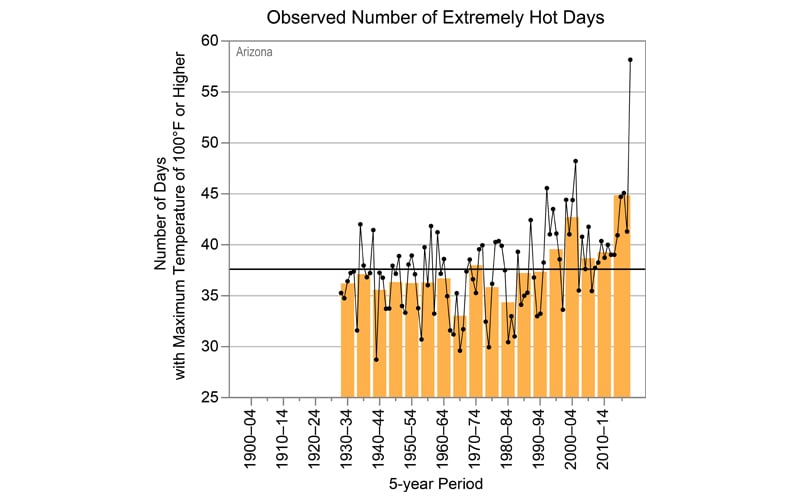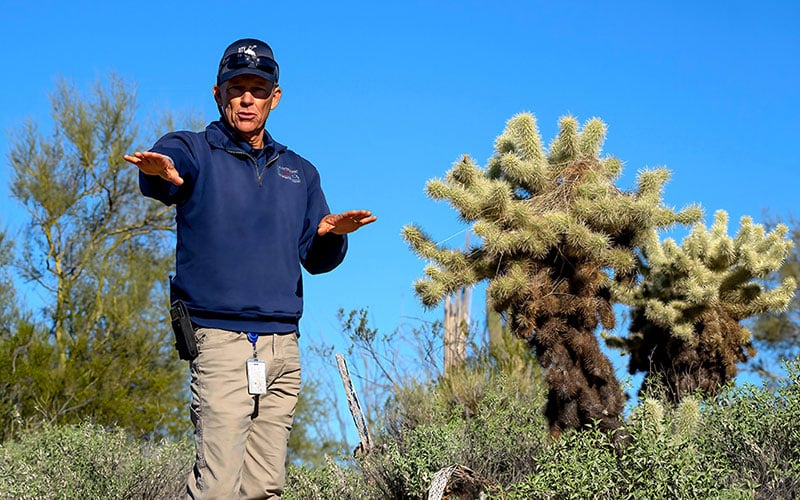PHOENIX – John Loleit has kept a watchful eye on the towering saguaros and well-worn trails of the McDowell Sonoran Preserve for 22 years.
Loleit, the natural resources coordinator for Scottsdale, takes to the wilds of the 47-square-mile park almost every day in all weather, mending fences, leading hikes and training park employees and volunteers.
He encourages visitors to use their powers of observation to look for clues about what’s happening to the environment around them from year to year.
“I tell folks, pick out a saguaro cactus, and that’s your saguaro. Every time you pass by, just take a look at it. Look at the main trunk,” Loleit said. “Over a period of time, are you seeing that it’s thin, and its ribs are shrinking and losing water or then they’re opening up and fat if we’ve got rain?”
The city hired Loleit – who had a 25-year career with the National Park Service – to open Pinnacle Peak Park in north Scottsdale in 2000. He has been a fixture at the McDowell Sonoran Preserve ever since.
Loleit has observed a lot of changes at the preserve over the decades, especially when it comes to the impact of high summer temperatures on the Sonoran Desert. And the latest summary of climate data from the National Oceanic and Atmospheric Administration predicts Arizona’s climate will continue to warm, leading to rising temperatures, more intense wildfires, and ongoing drought.
Loleit is familiar with the preserve’s seasonal ups and downs, but he has noticed changes. For instance, more saguaro arms that have fallen onto trails in recent years, and more saguaros that have toppled.
“This past summer, I thought, ‘Oh man, even the native plants, they’re stressed.’ You could see it,” Loleit said. “They had dropped a lot of leaves, or the color had changed quite a bit. It didn’t look like they’re happy campers.”
Is this a result of stress from climate change? Maybe, Loleit said.
“We’re in a 20-plus-year drought,” Loleit said. “It’s ironic when I hear people say, ‘Oh yeah, we’ve been through droughts before.’ If we look at history in the Phoenix area 800 to a thousand years ago, the Hohokam culture built massive canal systems throughout this valley and were able to irrigate thousands of acres. But it still wasn’t enough, and they had to leave.
“I just wonder if history will at some point repeat itself, and if we have enough time to change.”
Loleit’s observations reflect the fact that Arizona’s average temperatures are increasing in line with global climate change.
NOAA’s National Centers for Environmental Information released its 2022 State Climate Summaries for all 50 states in January.
The 2022 Arizona State Climate Summary report details the newest temperature, precipitation and climate data in the state from 2017 to 2020, in addition to historical data.
The report found that “temperatures in Arizona have risen 2.5 degrees (Fahrenheit) since the beginning of the 20th century … (and) historically unprecedented increases in annual average temperature are projected during this century.”
It also states that “the potential for more extended droughts in the future will pose a major challenge to Arizona’s environmental, agricultural and human systems. The risk of very large wildfires is projected to increase.”
And the high variability of monsoon rainfall also is expected to continue.
State climate summaries are all about the power of observation.
As Arizona’s state climatologist and a senior lecturer at Arizona State University, Erinanne Saffell, contributed to the summary’s data. She also publishes monthly state summaries about Arizona’s climate.
Climatology is about statistical representation of climate history, Saffell said, and the state summaries provide critical perspective that helps us to better understand what’s happening now.
“They help us assess where we are, where we’ve been. And then from there, we can perhaps connect to where we might go.” Saffell said.
At first glance, the findings of the NOAA summary don’t seem all that surprising: Over the course of the past five years, Arizona got hotter and drier, and these trends are expected to continue.
But there’s more to it than that, Saffell said.
“When we look at our current assessments, it does tell us that we’re seeing more of the same things. But we also need to understand that things are changing, and at what level they are changing becomes important,” she said.
According to the 2022 summary, “the number of extremely hot days (in Arizona) has been above average since 1995, with the highest number occurring during the 2015-2020 period.”
2020 was a particularly hot year, Saffell said, with the most days on record over 110 degrees Fahrenheit in the past 50 years.

(Graphic by NOAA National Centers for Environmental Information)
The NOAA summary also indicates that “the number of nights with a minimum temperature of 80°F or higher has been trending upward since 1995, also reaching a record high during the 2015 to 2020 period.”

(Graphic by NOAA National Centers for Environmental Information)
Saffell and other experts have been monitoring the minimum nighttime temperature data closely.
“If we zoom in and we look at what’s happening in our metropolitan areas, we can see that urbanization produces a higher signature of climate change,” Saffell said. “The increase in temperatures in Phoenix in the last 50 or 60 years is much larger than the signature we see across the state.”
Urbanization is the conversion of natural surfaces, such as shrubs and sand, into harder surfaces, like concrete and asphalt.
These urban surfaces absorb heat during the day and then re-emit heat into the atmosphere at night, which raises summer nighttime temperatures. This is called the urban heat island effect.
Extreme daytime temperatures make it harder for urban areas to cool off at night, which increases the likelihood of serious human health impacts, said David Hondula, who directs Phoenix’s new Office of Heat Response and Mitigation.
Phoenix has seen a 430% increase in the number of heat-related deaths since 2014, Hondula said in a Feb. 2 presentation to a City Council subcommittee. A large percentage of those deaths are connected to the increase in the number of unsheltered people downtown, Hondula said.
“Those individuals are on the front lines of risk when it comes to summer heat,” he said. “Anything we can do to provide simple measures that can keep people cool, safe and alive this coming summer will be a big priority.”
The human body is extremely receptive to changes in heat, Hondula said, and people experiencing heat-related illnesses are the true experts, feeling and observing the changes from year to year.
Understanding changes in precipitation is a little more complicated.
The 2022 summary indicated that “the 2020 monsoon season was the driest on record, with only 1.5 inches of precipitation, well below the previous record low.”
The summary also predicted monsoon seasons in Arizona will continue to be highly variable. 2020, for example, was devastatingly dry, followed by 2021, which was one of the wettest years on record.
Saffell said this “boom or bust” monsoon cycle is typical of living in a desert.
“When we look at our summer precipitation, we recognize some seasons will be wet, some will be dry,” Saffell said. “What we pay more attention to, is what happens with our winter precipitation because this is really important for our water supply.”
The majority of Arizona’s water comes from groundwater that is recharged by winter precipitation, Saffell said.
Scientists monitor snowpack in the upper and lower basins of the Colorado River, which is essential for recharging groundwater sources, Saffell said.
Snowpack levels in the lower basin, which includes Arizona, are below average, even though 2021 brought a good amount of rain and snow, Saffell said.
But one wet event or one wet year does not point to a trend, Saffell said.
“It’s important to understand the scale we’re dealing with,” she said. “When we’re looking at global-scale situations, it’s not necessarily what we’re seeing when we zoom into a state scale for precipitation. But what we’re seeing in Arizona is along the lines of what we’re seeing with changes globally for temperature in the last 100 years or so.”
The continued extremes in temperature and prolonged droughts in Arizona are also seen at the global scale. The NOAA recently reported that 2021 was the sixth warmest year on record for the globe since precise, comprehensive record keeping began in 1880.
Phoenix is taking steps to adapt to and mitigate the effects of climate change. In October, the City Council approved its updated Climate Action Plan, which speaks to changes in transportation systems, buildings and more that will reduce or limit greenhouse gas emissions.
This is all part of the global effort to reduce emissions to combat global scale climate change, Hondula said.
“There are efforts happening locally to combat any warming effects associated with urbanization,” he said. “We are exploring what a cool roof program might look like and there are smart efforts underway to think about abating future temperature change driven by urbanization. So there’s a lot happening across the board with respect to long term change.”




